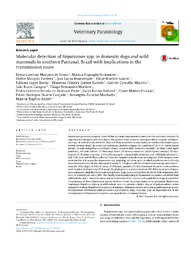Molecular detection of Hepatozoon spp. in domestic dogs and wild mammals in southern Pantanal, Brazil with implications in the transmission route.
Molecular detection of Hepatozoon spp. in domestic dogs and wild mammals in southern Pantanal, Brazil with implications in the transmission route.
Author(s): SOUSA, K. C. M. de; FERNANDES, M. P.; HERRERA. H. M.; BENEVENUTE, J. L.; SANTOS, F. M.; BARRETO, W. T. G.; MACEDOB, G. C.; CAMPOSB, J. B.; MARTINS, T. F.; ROCHA, F. L.; PINTOC, C. E. de A.; BATTESTI, D. B.; PIRANDAF, E. M.; CANCADO, P. H. D.; MACHADO, R. Z.; ANDRÉA, M. R.
Summary: Hepatozoon parasites comprise intracellular apicomplexan parasites transmitted to vertebrate animals by ingestion of arthropods definitive hosts. The present work aimed to investigate the occurrence of Hepatozoon spp. in wild animals, domestic dogs and their respective ectoparasites, in southern Pantanal region, central-western Brazil, by molecular techniques. Between August 2013 and March 2015, 31 coatis (Nasua nasua), 78 crab-eating foxes (Cerdocyon thous), seven ocelots (Leopardus pardalis), 42 dogs (Canis lupus familiaris), 110 wild rodents (77 Thichomys fosteri, 25 Oecomys mamorae, and 8 Clyomys laticeps), 30 marsupials (14 Thylamys macrurus, 11 Gracilinanus agilis, 4 Monodelphis domestica and 1 Didelphis albiventris), and 1582 ticks and 80 fleas collected from the sampled animals were investigated. DNA samples were submitted to PCR assays for Hepatozoon spp. targeting 18S rRNA gene. Purified amplicons were directly sequenced and submitted to phylogenetic analysis. A high prevalence of Hepatozoon among carnivores (C. thous [91.02%], dogs [45.23%], N. nasua [41.9%] and L. pardalis [71.4%]) was found. However, ticks and fleas were negative to Hepatozoon PCR assays. By phylogenetic analysis based on 18S rRNA sequences, Hepatozoon sequences amplified from crab-eating foxes, dogs, coatis and ocelots clustered with sequences of H. canis, H. americanum and H. felis. The closely related positioning of Hepatozoon sequences amplified from wild rodents and T. macrurus marsupial to Hepatozoon from reptiles and amphibians suggest a possible transmission of those Hepatozoon species between hosts by ectoparasites or by predation. Hepatozoon haplotypes found circulating in wild rodents seem to present a higher degree of polymorphism when compared to those found in other groups of animals. Although rodents seem not to participate as source of Hepatozoon infection to wild carnivores and domestic dogs, they may play an important role in the transmission of Hepatozoon to reptiles and amphibians in Pantanal biome.
Publication year: 2017
Types of publication: Journal article
Unit: Embrapa Beef Cattle
Keywords: Hepatozoon spp
Observation
Some of Embrapa's publications are published as ePub files. To read them, use or download one of the following free software options to your computer or mobile device. Android: Google Play Books; IOS: iBooks; Windows and Linux: Calibre.
Access other publications
Access the Agricultural Research Database (BDPA) to consult Embrapa's full library collection and records.
Visit Embrapa Bookstore to purchase books and other publications sold by Embrapa.

